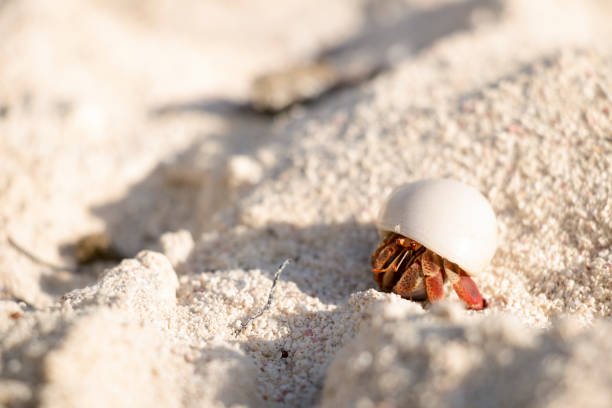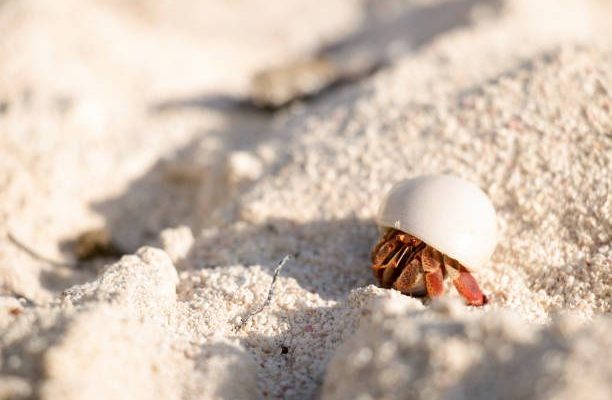
Think of hermit crabs like tiny nomads. They rely on their shells not only for protection but also for their sense of identity. But, as charming as they are, the world outside can be tough. From predators to habitat loss, these crabs must navigate a complex environment. Understanding these threats can help us appreciate their struggles and encourage conservation efforts.
1. Natural Predators
One of the most significant threats to hermit crabs is their natural predators. Just like a mouse has to watch out for a hungry cat, hermit crabs need to be wary of larger animals. Birds, fish, and even larger crabs see hermit crabs as a tasty snack.
Let me explain how this works. When a hermit crab ventures out of its shell to find food, it becomes vulnerable. This is when predators are most likely to strike. The crabs’ soft bodies are their Achilles’ heel. They’re often quick to retreat back into their shells, but sometimes that’s not enough.
You might be wondering how these crabs defend themselves. Their shells are their primary protection. If they can quickly find a new shell to move into, they have a better chance of surviving. But what happens if they can’t find a shell? This is where another threat begins.
2. Shell Shortages
Next up is the issue of shell shortages. Hermit crabs are known for their love of collecting and switching shells as they grow. It’s like a child outgrowing their shoes—eventually, they need a bigger pair. Unfortunately, not every hermit crab can find a suitable shell.
Many shells are taken by other creatures or damaged. This creates a competition among the crabs, leading to stress and conflict. When hermit crabs can’t find a shell, they may remain exposed, making them easy targets for predators.
Here’s the thing: if the supply of shells becomes too low, it could threaten entire populations of hermit crabs. Without a safe home, their future begins to look grim. Conservation efforts are essential to ensure that these crabs can continue to thrive.
3. Pollution
Pollution is another critical threat affecting hermit crabs and other marine life. When we think of pollution, we might picture garbage on the beach or oil spills in the ocean. But it goes beyond just visible trash.
Chemicals from fertilizers, pesticides, and plastics can seep into the ocean, affecting the very habitats where hermit crabs live. As these pollutants accumulate, they can compromise the health of crabs, making them more susceptible to diseases or even death.
Have you ever wondered how pollution alters their feeding habits? When crabs scavenge for food, they might unintentionally consume contaminated materials. This can lead to health issues that could wipe out populations over time. The cycle of pollution impacts everyone in the ecosystem, including us.
4. Habitat Destruction
Habitat destruction is another pressing threat. As coastal development increases—think hotels, condos, and roads—the natural habitats of hermit crabs are often obliterated. This leads to a loss of food sources and safe nesting grounds.
Imagine if you had to move every time your neighborhood changed. That’s what hermit crabs face when their homes are destroyed. Even if they can find a new place, it might not have the right conditions to thrive. This can lead to stress, competition for resources, and ultimately, declining populations.
Conservation efforts focus on preserving coastal areas, but it requires collective action. If we continue to encroach upon these habitats without consideration, we risk losing these little creatures forever.
5. Climate Change
Climate change isn’t just about rising temperatures; it affects hermit crabs as well. As ocean temperatures rise, it disrupts the entire marine ecosystem. This can lead to coral bleaching, altering the habitats where hermit crabs live and feed.
In addition, changing weather patterns can affect food availability. When storms become more intense or frequent, they can alter the landscape, further threatening hermit crabs. You might even see an increase in strandings or injuries due to harsh conditions, leaving them at the mercy of their environment.
Keeping climate change in check is crucial for survival, not just for hermit crabs but for all marine life. Every little effort counts, from reducing carbon footprints to supporting sustainable practices.
6. Invasive Species
Invasive species pose a major threat to hermit crabs as well. These are non-native species that overpopulate and disrupt the ecosystem. For example, some larger crabs or predators introduced to new environments can outcompete or prey on hermit crabs.
Think of it like a new kid in school who takes all the attention from everyone else. Invasive species can create a ripple effect through the food chain, making life harder for native species. When hermit crabs find themselves competing for resources or dealing with new threats, their survival can be compromised.
The impact of invasive species emphasizes the need for careful monitoring and management of coastal ecosystems. The balance of nature is delicate, and changes can lead to unforeseen consequences.
7. Overharvesting
Lastly, overharvesting poses a threat to hermit crab populations. In many areas, they are collected for the pet trade. While it’s great that people love these creatures, unsustainable collection practices can harm wild populations.
Think of it like a favorite book at the library. If too many people take it out, there won’t be any left for future readers. When hermit crabs are removed from their natural habitat at high rates, it can lead to a decline in their numbers.
Responsible practices and awareness about sustainable harvesting are essential. Supporting ethical sources ensures that hermit crab populations can remain stable and healthy.
In conclusion, hermit crabs face a multitude of threats in the wild—from natural predators to pollution and habitat destruction. By understanding these challenges, we can appreciate the importance of conservation efforts. Each species, no matter how small, plays a role in the ecosystem’s balance.
As we navigate our lives and make choices, let’s remember that even the tiniest creatures matter. Working together, we can ensure future generations will have the chance to marvel at hermit crabs in their natural habitats, scuttling along the shorelines with their quirky shells.

